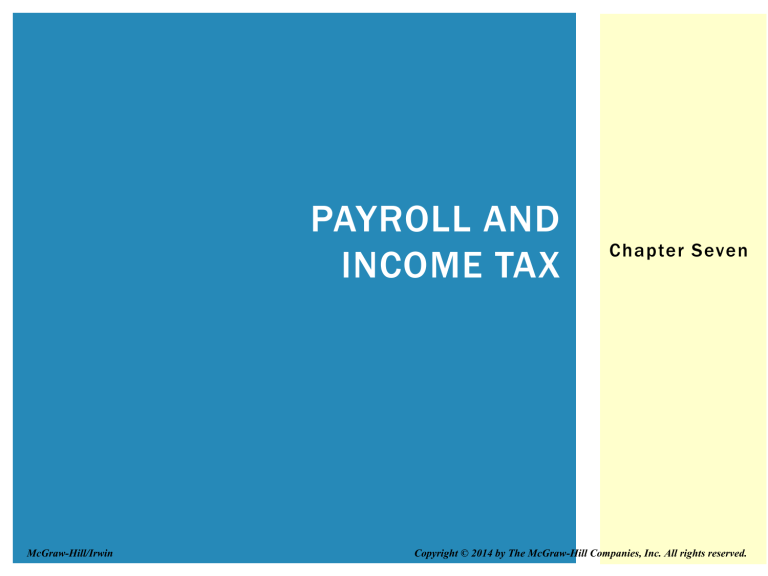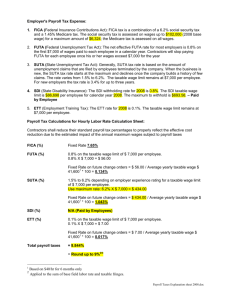
PAYROLL AND
INCOME TAX
McGraw-Hill/Irwin
Chapter Seven
Copyright © 2014 by The McGraw-Hill Companies, Inc. All rights reserved.
LEARNING UNIT OBJECTIVES
LU 7-1: Calculating Various Types of Employees’ Gross Pay
1.
Define, compare, and contrast weekly, biweekly, semimonthly, and
monthly pay periods.
2.
Calculate gross pay with overtime on the basis of time.
3.
Calculate gross pay for piecework, differential pay schedule, straight
commission with draw, variable commission scale, and salary plus
commission.
LU 7-2: Computing Payroll Deductions for Employees’ Pay; Employers’ Responsibilities
1. Prepare and explain the parts of a payroll register.
2. Explain and calculate federal and state unemployment taxes.
LU 7-3: Calculating Taxable Income and Tax Liability
1. Compute taxable income.
2.
Calculate tax liability.
7-2
PAYROLL CYCLES
7-3
HOURLY RATE OF PAY;
CALCULATION OF OVERTIME
Gross pay = Hours employee worked x Rate per hour
Hourly overtime pay rate = Regular hourly pay rate x 1.5
Gross pay = Earnings for 40 hours + Earnings at time-and-a-half rate
7-4
HOURLY RATE OF PAY; CALCULATION OF
OVERTIME
Employee
M
T
W
Th
F
R Valdez
13
8.5
10
8
11.25
S
10.75
Total
61.5
*Rate is $9.00 per hour.
Hourly overtime pay rate = Regular hourly pay rate x 1.5
Gross pay = Earnings for 40 hours + Earnings at time-and-a-half rate
61.5 – 40 = 21.5 overtime hours
$9 x 1.5 = 13.50 overtime rate
(40 hours x $9) + (21.5 hours x 13.5)
$360 + $290.25 = $650.25
7-5
STRAIGHT PIECE RATE PAY
Gross pay = Number of units produced x Rate per unit
Example:
Ryan Foss produced 900 dolls. He is paid $.96 per doll. Calculate his
gross pay.
900 dolls x $.96 = $864.00
7-6
DIFFERENTIAL PAY SCHEDULE
Gross pay = Number of units produced x Various rates per unit
Example:
Logan Company pays Abby Rogers on the basis of the following schedule:
Last week Abby produced 300 dolls. What is Abby’s gross pay?
(50 x $.50) +(100 x $.62)+(50 x $.75) + (100 x $1.25) = $249.50
7-7
STRAIGHT COMMISSION WITH DRAW
Commission is a certain percentage of the amount a salesperson sells.
Draw is an advance on the salesperson’s commission.
Example:
Logan Company pays Jackie Okamoto a straight commission of 15% on
her net sales (net sales are total sales less sales returns). In May, Jackie
had net sales of $56,000. Logan gave Jackie a $600 draw in May. What is
Jackie’s gross pay?
($56,000 x .15) = $8,400
-- 600
$7,800
7-8
VARIABLE COMMISSION SCALE
Different commission rates for different levels of net sales.
Example:
Up to $35,000
Last month, Jane Ring’s net sales were
$160,000. What is Jane’s gross pay
based on the schedule?
4%
Excess of $35,000 to $45,000 6%
Over $45,000
8%
($35,000 x .04) + ($10,000 x .06) + ($115,000 x .08)
= $1,400
+
$600
+
$9,200
= $11,200
7-9
SALARY PLUS COMMISSION
Gross pay = Salary + Commission
Example:
Logan Company pays Joe Roy a $3,000 monthly salary plus a 4% commission
for sales over $20,000. Last month Joe’s net sales were $50,000. Calculate
Joe’s gross pay.
$3,000 + ($30,000 x .04) = $4,200
7-10
EMPLOYEE’S W-4 FORM
• When an employee is hired, a W-4 Form is completed.
• This information is needed to calculate the federal income tax.
7-11
PAYROLL REGISTER
Rate
Base
Social Security
6.20%
$110,100
Medicare
1.45
No Base
FICA taxes fund Social Security and Medicare.
7-12
FEDERAL INCOME TAX WITHHOLDING
(FIT)
1. Percentage Method
7-13
PERCENTAGE METHOD INCOME TAX
WITHHOLDING TABLES
TABLE 7.1
TABLE 7.2
(Partial)
You can use
the
percentage
method to
calculate
federal
income tax
withholding
(FIT).
7-14
PERCENTAGE METHOD
Example: Alice Rey earns $2,250 for week 47. She is married with two allowances.
Step 1. In Table 7.1, locate the
weekly withholding for
one allowance. Multiply
this number by 2.
$73.08 x 2 = $146.16
$2,250.00
-- 146.16
$2,103.84
Step 2. Subtract Step 1 from
employee’s pay.
Step 3. In Table 7.2, locate
appropriate table and
compute income tax.
$2,103.84
-- 1,515.00
$ 588.84
Tax $187.15 + .25 ($588.81)
$187.15 + 147.21 = $334.36
7-15
EMPLOYERS’ RESPONSIBILITIES
Federal Unemployment Tax Act (FUTA) —
6.2% tax on the first $7,000 paid to employees as
wages during the calendar year
State Unemployment Tax Act (SUTA) *–
5.4% tax on the first $7,000 paid to employees as
wages during the calendar year
6.2% FUTA
5.4% SUTA credit
.8% FUTA tax
*Can be credited against the 6.2% federal rate.
Example:
Assume a company had total wages of $19,000 in a calendar year. No employee
earned more than $7,000 during the calendar year. The FUTA tax is .8% (6.2%5.4%) . How much does the company pay in FUTA tax?
.008 x $19,000 = $152 FUTA tax due to federal government
7-16
EMPLOYERS’ RESPONSIBILITIES
Federal Unemployment Tax Act (FUTA) —
6.2% tax on the first $7,000 paid to employees as
wages during the calendar year
State Unemployment Tax Act (SUTA) *–
5.4% tax on the first $7,000 paid to employees as
wages during the calendar year
6.2% FUTA
5.4% SUTA credit
.8% FUTA tax
*Can be credited against the 6.2% federal rate.
Example:
Assume a company has total wages of $19,000 and $4,000 of the wages are
exempt from SUTA. What are the company’s SUTA and FUTA taxes if the
company’s SUTA rate is 5.8% due to a poor employment record?
$20,000 -- $4,000 (exempt wages) = $16,000
SUTA = $16,000 x .058 = $928; FUTA = $16,000 x .008 = $128
7-17
CALCULATING TAXABLE INCOME
AND TAX LIABILITY
• In the United States, the tax liability – what is owed to the
government – is based on calculated taxable income and the
IRS tax rate schedules (tax tables).
• Keep in mind a taxpayer in the 25% bracket saves 25 cents in
federal income tax for each dollar spent on a deductible
expense.
• Knowing what is a deductible expense can go a long way
toward effective tax planning.
7-18
CALCULATING TAXABLE INCOME
Step 1. Total all income.
Step 2. Subtract from Step 1 any adjustments to income to
calculate adjusted gross income.
Step 3. Subtract from Step 2 the standard deduction (see
Figure 7.2) or the total of itemized deductions --whichever is greater.
Step 4. Subtract from Step 3 the exemption allowance,
found by multiplying the total number of
exemptions claimed by the exemption amount.
See Figure 7.2.
Taxable Income = Adjusted gross income
— Standard or itemized
deductions
— Exemption allowance
7-19
2012 STANDARD DEDUCTION AND
EXEMPTION AMOUNT – FIGURE 7.2
7-20
CALCULATING TAXABLE INCOME
Example: Calculate taxable income for Bree Langemo who files as
head of household and claims two exemptions. She earned
$95,720; sold stock with a capital gain totaling $2,500; earned a
$1,750 bonus, had a capital loss of $7,000; contributed $2,000 to
her IRA; had moving expenses of $15,500, mortgage interest of
$12,500, and charitable contributions of $450.
Step 1. $95,720 + $2.500 = $1.750 - $7,000 = $92,970.
Step 2. $92,970 - $2,000 = $90,970.
Step 3. Choose the greater of the two: standard deduction of
$8,700 (from Figure 7.2) or itemized deductions of $28,450
($15,500+$12,500+$450). Itemized deductions are greater, so
$90,970 - $28,450 = $62,520.
Step 4. $62,520 – ($3,800 x 2) = $54,920 taxable income
7-21
DETERMINING INCOME TAX LIABILIT Y
Example 1: Mary Frey files head of household and has taxable income
of $86,500. Calculate her tax liability.
Step 1. Locate the filing status in Figure 7.2.
Her filing status is Head of Household.
7-22
DETERMINING INCOME TAX LIABILIT Y
Example 1: Mary Frey files head of household and has taxable income
of $86,500. Calculate her tax liability.
Step 2. Find the taxable income bracket in Table 7.3.
Her taxable income lies within the over $47,350 but
not over $122,300.
7-23
DETERMINING INCOME TAX LIABILIT Y
Example 1: Mary Frey files head of household and has taxable income
of $86,500. Calculate her tax liability.
Step 3. Calculate the tax owed for each bracket.
10% on taxable income from $0 to $12,400: $12,400 x .10 = $1.240
15% on taxable income over $12,400 to $47,350: $47,350 - $12,400
= $34,950 x .15 = $5,242.50
25% on taxable income over $47,350 to $122,300: $86,500 - $47,350
= $39,150 x .25 = $9,787.50
7-24
DETERMINING INCOME TAX LIABILIT Y
Example 1: Mary Frey files head of household and has taxable income
of $86,500. Calculate her tax liability.
Step 4. Total the taxes owed for each bracket to find the tax liability.
$1,240 + $5,242.50 + $9,787.50 = $16,270 tax liability
7-25





